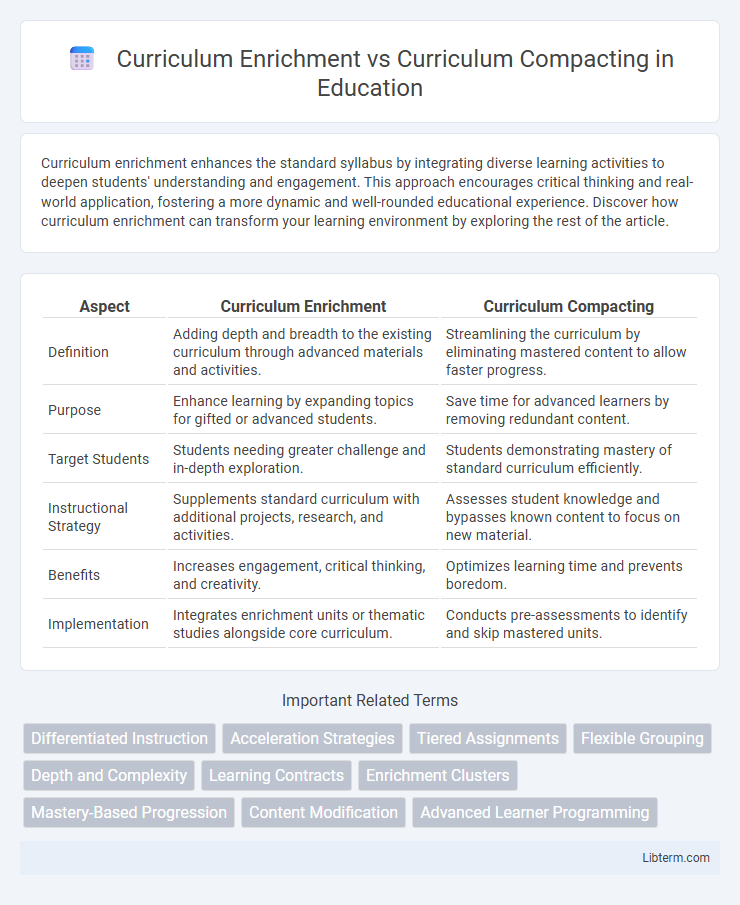Curriculum enrichment enhances the standard syllabus by integrating diverse learning activities to deepen students' understanding and engagement. This approach encourages critical thinking and real-world application, fostering a more dynamic and well-rounded educational experience. Discover how curriculum enrichment can transform your learning environment by exploring the rest of the article.
Table of Comparison
| Aspect | Curriculum Enrichment | Curriculum Compacting |
|---|---|---|
| Definition | Adding depth and breadth to the existing curriculum through advanced materials and activities. | Streamlining the curriculum by eliminating mastered content to allow faster progress. |
| Purpose | Enhance learning by expanding topics for gifted or advanced students. | Save time for advanced learners by removing redundant content. |
| Target Students | Students needing greater challenge and in-depth exploration. | Students demonstrating mastery of standard curriculum efficiently. |
| Instructional Strategy | Supplements standard curriculum with additional projects, research, and activities. | Assesses student knowledge and bypasses known content to focus on new material. |
| Benefits | Increases engagement, critical thinking, and creativity. | Optimizes learning time and prevents boredom. |
| Implementation | Integrates enrichment units or thematic studies alongside core curriculum. | Conducts pre-assessments to identify and skip mastered units. |
Understanding Curriculum Enrichment
Curriculum Enrichment involves enhancing the standard curriculum by incorporating advanced content, experiential learning, and interdisciplinary connections to deepen students' understanding and engagement. This approach targets diverse learners by expanding knowledge and skills beyond core requirements, promoting creativity and critical thinking. Effective curriculum enrichment requires aligning enriched activities with educational goals to ensure meaningful and relevant learning experiences.
Defining Curriculum Compacting
Curriculum compacting is an instructional strategy designed to streamline the regular curriculum by identifying and eliminating content that students have already mastered, thereby allowing more time for advanced learning opportunities. It contrasts with curriculum enrichment, which involves adding supplementary activities to deepen understanding rather than removing existing content. Effective curriculum compacting enhances gifted education by tailoring instruction to individual student needs, promoting engagement and preventing redundancy.
Key Differences Between Enrichment and Compacting
Curriculum enrichment involves adding supplementary content or activities to enhance students' learning experiences, while curriculum compacting focuses on streamlining the existing curriculum by eliminating redundancy to allow advanced learners to progress faster. Enrichment expands the curriculum scope and depth, providing broader learning opportunities, whereas compacting prioritizes efficiency by tailoring the curriculum pace to individual student readiness. Key differences also include enrichment targeting all students for deeper understanding, while compacting specifically addresses gifted or advanced learners to reduce repetition.
Objectives of Curriculum Enrichment
Curriculum Enrichment aims to deepen students' understanding by adding breadth and complexity to the existing curriculum, fostering critical thinking and creativity beyond standard content. Its objectives include enhancing student engagement through diverse learning experiences and promoting higher-order skills by integrating interdisciplinary themes. This approach supports differentiated learning by providing meaningful challenges that extend knowledge without accelerating the pace of content coverage.
Goals of Curriculum Compacting
Curriculum compacting aims to streamline the learning process for advanced students by identifying and eliminating content they have already mastered, allowing more time for enrichment and in-depth exploration. The primary goals include accelerating learning pace, increasing engagement through challenging activities, and fostering critical thinking skills beyond the standard curriculum. This approach enhances educational efficiency and promotes personalized learning pathways tailored to students' competencies.
Benefits of Curriculum Enrichment for Students
Curriculum Enrichment enhances student engagement by broadening learning experiences beyond the standard syllabus, fostering critical thinking and creativity. It provides opportunities for deeper exploration of subjects, promoting a more well-rounded and motivated learner. Enriched curricula support diverse learning styles, aiding student retention and academic growth.
Advantages of Curriculum Compacting in the Classroom
Curriculum compacting allows teachers to streamline instruction by eliminating content students have already mastered, providing more time for advanced or differentiated learning activities. This approach promotes student engagement and motivation by offering tailored challenges that align with their readiness and interests. By reducing redundancy, curriculum compacting enhances instructional efficiency and supports accelerated learning paths within the classroom.
Challenges in Implementing Enrichment Strategies
Implementing curriculum enrichment presents challenges such as balancing depth and breadth of content while catering to diverse student interests and learning styles. Educators often face time constraints and limited resources, making it difficult to integrate supplementary materials without overwhelming the core curriculum. Ensuring alignment with educational standards and measuring the effectiveness of enrichment activities also complicates consistent application.
Practical Approaches to Curriculum Compacting
Curriculum Compacting streamlines standard content by eliminating redundancy and accelerating instruction, allowing gifted students to engage in advanced or enrichment activities without unnecessary repetition. Practical approaches include pre-assessment to identify mastered skills, flexible pacing to adjust learning speed, and substitution with higher-order tasks that deepen understanding and critical thinking. This method enhances student motivation and learning efficiency by customizing curriculum to individual readiness levels while maintaining rigorous academic standards.
Choosing the Right Strategy for Diverse Learners
Curriculum enrichment expands learning opportunities by adding depth and complexity, ideal for gifted students needing challenge beyond standard content. Curriculum compacting streamlines instruction by eliminating already-mastered material, allowing advanced learners to progress at an accelerated pace. Selecting the right strategy depends on accurately assessing student readiness, ensuring the approach aligns with individual learning profiles to maximize engagement and achievement.
Curriculum Enrichment Infographic

 libterm.com
libterm.com